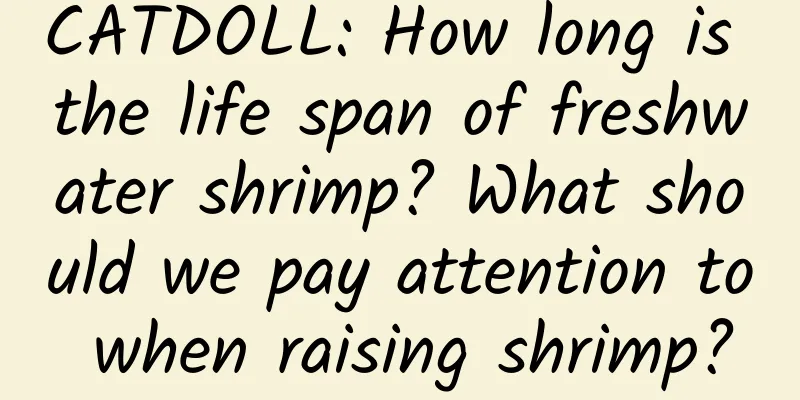CATDOLL : CATDOLL: How long is the life span of freshwater shrimp? What should we pay attention to when raising shrimp?

|
The life span of green shrimp is relatively short, generally 14 to 18 months, and the life span of male shrimp is shorter than that of female shrimp. Green shrimp that have overwintered generally die in July or August of the following year. During the breeding process of freshwater shrimp, it is important to catch them in batches. Starting from September of the current year, large shrimps over 4 cm in length should be caught continuously, and small shrimps should be kept for breeding. The adult shrimps of the following year should be caught and put on the market before June or July. The reasons are as follows: (1) Freshwater shrimp grow very fast. There is a saying that "it takes 45 days to catch up with the mother shrimp". It means that after 45 days of growth, the body length of the young shrimp can catch up with the length of the mother shrimp, reaching about 3 cm. Generally, the young shrimps hatched in June each year, in October of the same year, the male shrimps can reach 4 to 5 cm in length and weigh 3 to 5 grams. After one year of growth, the male shrimps can generally reach a length of more than 7 cm, and the female shrimps can reach a length of 5 to 6 cm. A few male shrimps can reach a length of more than 10 cm and weigh about 10 grams, while the female shrimps can reach a length of more than 8 cm and weigh about 7 grams. However, green shrimps mature early and have strong reproductive capacity. Female shrimps can lay eggs many times. Green shrimps with large individuals and well-developed gonads can reproduce offspring in September and October of the same year. Therefore, even if shrimp fry of the same size are released, the result will still be several generations in the same pond. There are differences in the feeding competition ability between green shrimps, coupled with the uneven artificial feeding and the individual differences between female and male shrimps, which bring difficulties to the effective control of breeding density and the cultivation of adult shrimp ponds. If a part of the adult shrimps that have reached the market size can be caught in time according to the growth of green shrimps, so that the shrimps left in the pond can continue to grow, it will also be conducive to the balanced listing of live shrimps, preventing the market from "no shrimps to eat" in the middle of breeding, and concentrated listing in the late stage of breeding, resulting in "difficult to sell shrimps", which is conducive to improving social and economic benefits. It is also conducive to capital turnover, reducing costs, and creating conditions for expanding reproduction. (2) Increasing production is the ultimate goal of shrimp farming. Under dense conditions, the growth of freshwater shrimp should be promoted so that the size of freshwater shrimps out of the pond is basically the same, and the production per unit area is increased. Only by fishing in batches and multiple times can the density be thinned out in time, the restriction of excessive density on group growth can be alleviated, and a more appropriate density can be maintained to promote the growth of freshwater shrimps. Practice has shown that the yield of one-time fishing is 40% to 50% lower than that of multiple fishing in batches, or even lower. (3) After wintering, the shrimp will mate and reproduce in the spring. The male shrimp will die soon after mating, and the female shrimp will also die one after another after the reproduction is over. Therefore, clearing the pond in time and catching the big ones and leaving the small ones is a good way to reduce losses and improve economic benefits. |
>>: CATDOLL: Which one is more nutritious, shrimp or crucian carp?
Recommend
CATDOLL: The top ten tree species suitable for raising cicadas (The top ten tree species suitable for raising cicadas)
1. What plants should be used to grow cicadas in ...
CATDOLL: How to raise spiders (How to raise golden spiders)
1. How to raise spiders and what should you pay a...
CATDOLL: Who knows what flies eat? I only saw them landing on food but I didn't see them eating.
Who knows what flies eat? I only saw them landing...
CATDOLL: What is the prospect of raising mealworms? Is it suitable for our area? How is the sales? Is it a scam?
1. What is the prospect of raising mealworms? Is ...
CATDOLL: Why are there so many shrimps and crabs in foreign countries, but not enough in China?
Why are there so many shrimps and crabs in foreig...
CATDOLL: Treatment and precautions for piglet gastroenteritis
Treatment of gastroenteritis in piglets Piglet ga...
CATDOLL: What is the wasp's nest made of?
1. What is the material of the wasp's honeyco...
CATDOLL: How to grow goldfish flowers_How to grow goldfish flowers?
Goldfish Chlorophytum comosum is also known as Ke...
What do cats eat during the weaning period?
Cats in the weaning period are suitable for eatin...
Why do cats like to lick themselves?
Reasons why cats like to lick themselves: 1. When ...
CATDOLL: What does the fish testis consist of?
1. What does the fish testis consist of? The fish...
CATDOLL: The sad diary is the most painful
The most painful thing about the sad diary Some s...
CATDOLL: The reason why grouper changes sex
1. The reason for the sex change of grouper Accor...
Why do cats sleep in the litter box?
Why do cats sleep in the litter box? 1. Cats are ...
CATDOLL: The best species of ants to keep
The best species of ants to raise Ants have a rel...









